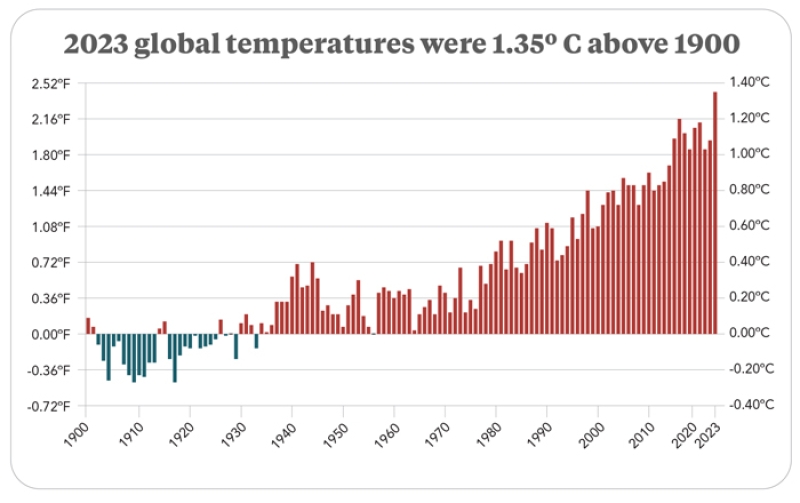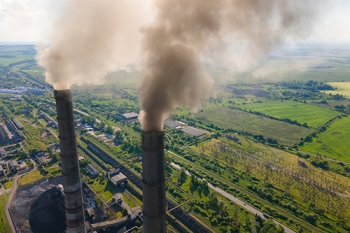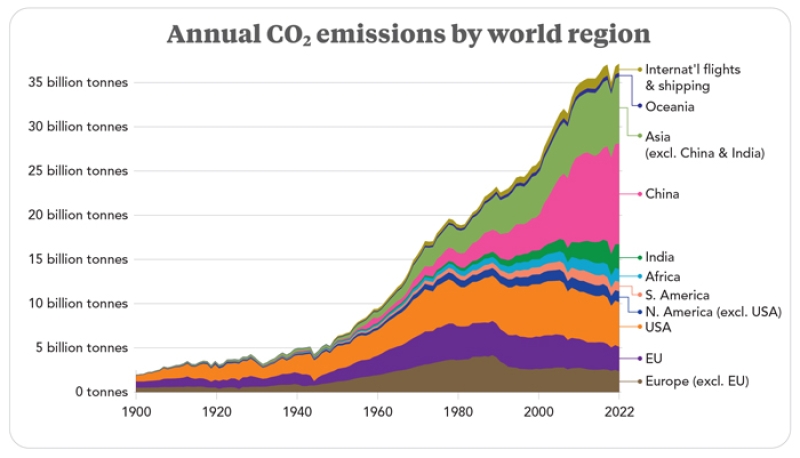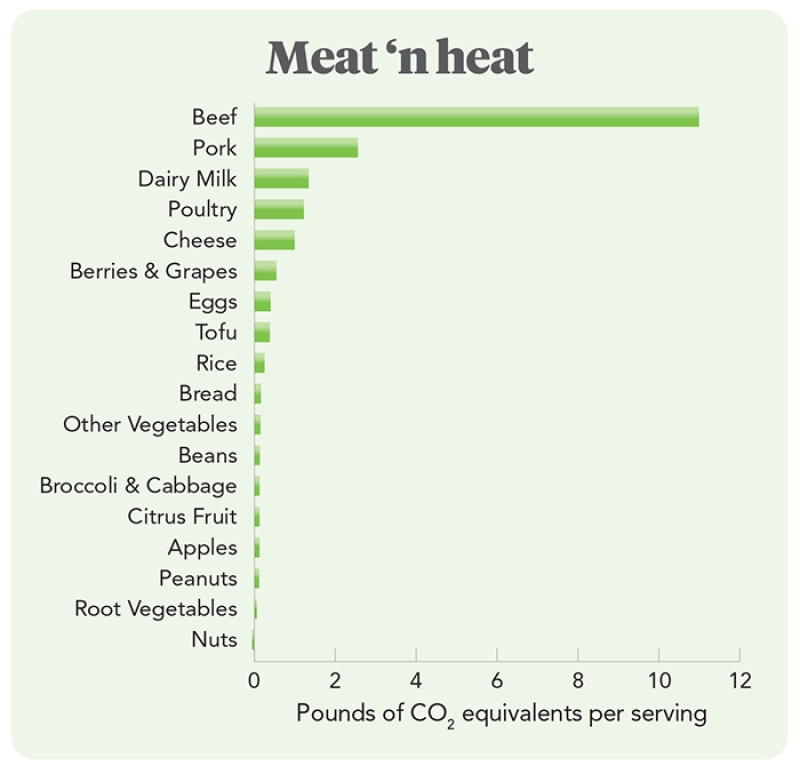Earth on the edge: What to know about diet and climate
“Climate change is here,” said United Nations Secretary-General António Guterres in July, the hottest month ever recorded. “It is terrifying. And it is just the beginning.” Here’s the latest on a planet entering off-the-charts territory...and the difference your diet can make.
1. 2023 was far warmer than expected.
“2023 was the world’s warmest year on record, by far,” announced the National Oceanic and Atmospheric Administration in January.
“The findings are astounding,” said NOAA Chief Scientist Sarah Kapnick at a global climate briefing.
2023’s heat “produced many costly climate driven weather events here in the United States and worldwide,” noted Kapnick.
“The U.S. alone had a record-breaking 28 separate billion-dollar weather and climate disasters this past year, causing over $90 billion in damages.”
The average global temperature for 2023 topped the pre-industrial (1850 to 1900) average by 1.35 degrees Celsius, reported NOAA.

That’s a bigger jump than experts expected. And it’s close to the 1.5º C limit set by the 2015 Paris Agreement to avoid the most devastating climate disasters.
“All of this is consistent with increasing concentrations of heat-trapping gases,” said Russell Vose, Chief of Climate Monitoring and Assessment at NOAA. “Carbon dioxide concentrations are about 50 percent higher than pre-industrial levels, methane is up about 150 percent, nitrous oxide about 25 percent.”
That explains a bump in warming, but not the 2023 leap.
“We’re frankly astonished,” said Gavin Schmidt, Director of NASA’s Goddard Institute for Space Studies. “This has been very, very unusual.”
El Niño—the warming in the southern Pacific Ocean—started to kick in after May. But that doesn’t explain the leap, either.
“We’ve had El Niños before, we’ve had bigger El Niños before,” observed Schmidt. “And they’ve never had that kind of impact on the global [average]temperature.”
A troubling sign: “The changes that we saw in Antarctica, particularly the very, very low sea ice levels during their winter,” added Schmidt, “was a contributor to the very large warmth that we saw starting from July and onwards.”
Less ice means that the Earth is absorbing—rather than reflecting—more of the sun’s rays.
“Whether [2023] was a blip or whether there’s something systematic that’s shifted, I think it’s too soon to tell,” said Schmidt.
But as the UN’s Guterres pointed out in July, “the only surprise is the speed of the change....The air is unbreathable. The heat is unbearable. And the level of fossil fuel profits and climate inaction is unacceptable.”
In fact, in the late 1970s, ExxonMobil scientists secretly predicted that fossil fuels would cause global warming “with dramatic environmental effects,” but publicly worked to deny it.
2. Tipping points loom ahead.
“The world has been continuing to heat up, thanks to our collective activities, such that we’re now clearly in the danger zone for triggering damaging tipping points,” said Tim Lenton at the COP 28 UN Climate Change Conference in 2023. Lenton is director of the Global Systems Institute at the University of Exeter in England.
A tipping point is when a tiny change can set off events that are “large, abrupt, and hard to reverse,” said Lenton.
For example, you can lean back in a chair, but once it reaches the tipping point, you’re headed for the floor.
Lenton led a team of more than 200 scientists to prepare the 2023 Global Tipping Points Report.
“The report is motivated by the alarming evidence that’s accumulated since I first started alerting the world to the risks of damaging climate tipping points over 15 years ago,” said Lenton. Now they’re perilously close.
“Five of those systems are already at risk,” warned Lenton. “That’s the large-scale loss of coral reefs in the tropics, catastrophic collapse of the Greenland ice sheet and the West Antarctic Ice Sheet, the loss abruptly of permafrost in the high Arctic, and a collapse of the Subpolar Gyre in the North Atlantic region.” (A gyre is a circular ocean surface current.)
The impacts would be dire.
“These are tipping points that pose threats of a magnitude that has never been faced before by humanity,” warned Lenton. “We’re talking about impacts like the global-scale loss of capacity to grow major staple crops.”
The good news: positive tipping points can protect the planet.
“For example, as markets are tipping to electric vehicles, this is reducing the price of batteries,” said Lenton. And lower-cost batteries “reinforce the positive tipping point to renewable energy.”
“And that, in turn, can trigger a positive tipping point in producing green ammonia, green hydrogen fuels, and so on.”
“But triggering positive tipping points doesn’t just happen.”
The report’s first recommendation, noted Lenton: “We need to phase out fossil fuels and land use emissions, starting now.”
3. Carbon dioxide (CO2) emissions need to drop.

Unfortunately, that’s not happening.
“Current emissions for 2023 are higher than ever,” said professor Pierre Friedlingstein of the University of Exeter, presenting the Global Carbon Project’s annual report at COP 28. “It’s about 1.1 percent higher than last year.”
Since the first COP meeting in 1995, “we are almost double in terms of global CO2 emissions from fossil fuels,” noted Friedlingstein. “It’s happening because of an increase in all sources—coal, oil, and gas.”
In 2023, China led the pack “with about 30 percent of total emissions,” said Friedlingstein. “Emissions in China have been increasing rapidly this year, about 4 percent.”
Likewise, emissions from India rose by 8 percent in 2023. In contrast, the European Union cut emissions by 7 percent and U.S. emissions dropped by about 3 percent.
That said, the U.S. has emitted the most CO2 since 1750. And the average American still emits nearly twice as much CO2 as the average person in China.
What about using technology to remove carbon dioxide from the air? That amounted to only 0.000025 percent of emissions in 2023.
“This is more than a million times smaller than current fossil fuel CO2 emissions,” said the Global Carbon Project.
At today’s rate of CO2 emissions, the remaining carbon budget leaves us only 7 years before we have a 50 percent chance of reaching 1.5º C of global warming.

4. Our diets can help—or harm—the planet.
What you eat for dinner isn’t going to make the planet safe for your children and grandchildren. But it can help.
“We looked at the carbon footprints of a half-dozen diets,” says Diego Rose, professor and nutrition program director at Tulane University.
His team analyzed the foods eaten by roughly 16,000 participants in the National Health and Nutrition Examination Survey.
“The big surprise was how large the range was,” says Rose.
“We expected vegan and vegetarian diets to have the smallest footprints because they have no meat.” (A vegan diet has no animal foods. A vegetarian diet includes dairy and eggs but no meat, poultry, or fish.)
“And we assumed that keto and paleo diets would have a larger footprint because they’re meat-heavy. But we didn’t expect a keto diet’s footprint to average over four times larger than that of a vegan diet. A paleo diet was close behind keto.”
(A paleo diet cuts grains, beans, and dairy, while a keto diet minimizes carbs from all foods.)
An omnivore diet’s carbon footprint was about double a vegetarian diet’s and triple a vegan diet’s.
But omnivore diets were not all the same. “The more people adhered to a DASH and especially a Mediterranean diet, the lower their carbon footprint,” says Rose.
A Mediterranean diet isn’t the pizza, lasagna, or gyros you’d get in an Italian or Greek restaurant.
“It’s mostly plant-based with fish,” Rose explains. “It has very little dairy or meat.”
A DASH (Dietary Approaches to Stop Hypertension) diet is also packed with vegetables and fruit, with only small servings of meat.
“You don’t have to be a vegan,” says Rose. “You can improve your carbon footprint by eating a more Mediterranean-like diet.”
The change that can do the most to slash your diet’s carbon footprint: eat less beef.
“Beef is the big one,” says Rose. “It has 8 to 10 times the impact of chicken and 50 times the impact of beans.” Even pork causes less harm than beef.
Beef eaters may find it easier to replace beef in a mixed dish than to skip a steak.

“If you’re talking about a pasta sauce, lasagna, or tacos or burritos, there are many other flavor elements that can swamp your palate, so it may not matter if you switch to chicken, ground turkey, or plant-based meat alternatives,” says Rose.
“Switching from dairy to soy milk or from apple juice to apples lowers your carbon footprint, but not as much as going from beef to chicken.”
And it’s not just carbon emissions. In a study of roughly 65,000 Americans’ diets, red and processed meats also used more cropland, more irrigation water, and more fertilizer than any other food group. Why?
“It’s mainly because we’re feeding foods that could be eaten by humans to animals,” says Walter Willett, professor of epidemiology and nutrition at the Harvard T.H. Chan School of Public Health.
“We have to devote vastly more resources, land, water, and fertilizer to basically feed animals rather than eating plant foods directly.”
And cows are ruminants. “Every minute, 24-7, ruminants generate methane both by breath and through the intestinal tract,” says Willett.
As a greenhouse gas, methane is 80 times more potent than carbon dioxide for the first 20 years after it’s released.
“We’re chopping down forests and plowing up prairies to grow food for animals,” says Willett.
“If people ate less meat, we wouldn’t have to touch the Amazon, we could let a big chunk of the Midwest go back to forest and prairies, and we could produce healthier diets at the same time.”
And because soy, corn, and beef are global commodities, what you eat matters, notes Willett.
“Each time you eat a healthy plant-based meal, you’re helping to preserve the Amazon.”
5. A healthy plant-based diet beats all.
A plant-based diet isn’t necessarily healthy.
“An unhealthy plant-based diet—which has large amounts of sugar and refined starch—is the worst diet of all,” says Willett.
Why is the U.S. diet so high in refined grains and added sugars?
“Unfortunately, there are incentives for manufacturers to make products out of refined starch and sugar,” says Willett.
“They have a long shelf life and minimal cost, so companies can promote them with lots of marketing and make lots of profit.”

In contrast, “a healthy plant-based diet includes more whole grains, fruits, vegetables, nuts, and legumes, including soy products, as the primary sources of calories,” says Willett.
In his team’s “healthy plant-based diet index,” those foods—along with tea, coffee, and unsaturated oils—gain points. In contrast, five unhealthy plant-based foods—fruit juices, refined grains, potatoes, sugary drinks, and sweets—lose points.
Diets also lose points for the animal foods they contain. But you don’t have to give them up entirely.
“A healthy plant-based diet can have modest amounts of poultry, fish, eggs, and dairy,” says Willett.
In studies that track thousands of people for years, those who get higher scores on the healthy plant-based diet index have a lower risk of cardiovascular disease, type 2 diabetes, some cancers, and frailty than those who get lower scores.
Those studies can’t prove that healthy plant-based diets cause lower risks, because something else about the people who eat them may be protective. But some of those findings are backed by evidence from clinical trials.
“A meta-analysis of 66 randomized trials looked at the effects of foods on risk factors for heart disease and type 2 diabetes like high blood pressure, high blood sugar, high LDL cholesterol, and high triglyceride levels,” says Willett.
“Nuts got the top score for lowering those risk factors, followed by legumes, whole grains, fish, and fruits and vegetables. That’s really the core of a plant-based diet.”
Why is a healthy plant-based diet better?
It’s not just that meat and full-fat dairy raise LDL (bad) cholesterol because they’re high in saturated fat. Or that people who eat red and processed meats have a higher risk of colorectal cancer.
“It’s also what animal and unhealthy plant foods are missing,” notes Willett. “For example, the soluble fiber in legumes, whole grains, fruits, and vegetables and the healthy fats in nuts and soy lower LDL.”
What’s more, the potassium in fruits and vegetables helps keep a lid on blood pressure.
In contrast, “refined starches and sugars raise triglycerides and lower HDL—or good—cholesterol,” says Willett.
“That’s part of the metabolic syndrome, which is a precursor of type 2 diabetes.”
“Why not go for the double win—a diet that’s good for people and for the planet?”
Continue reading this article with a NutritionAction subscription
Already a subscriber? Log in

OUR HEALTHLETTER
Subscribe to Nutrition Action
Nutrition Action is completely independent. We accept no advertising and take no donations from corporations or the government. So we’re free to blow the whistle on dishonest or unhealthy supplements, foods, and restaurant menu items—and to applaud the good ones.

